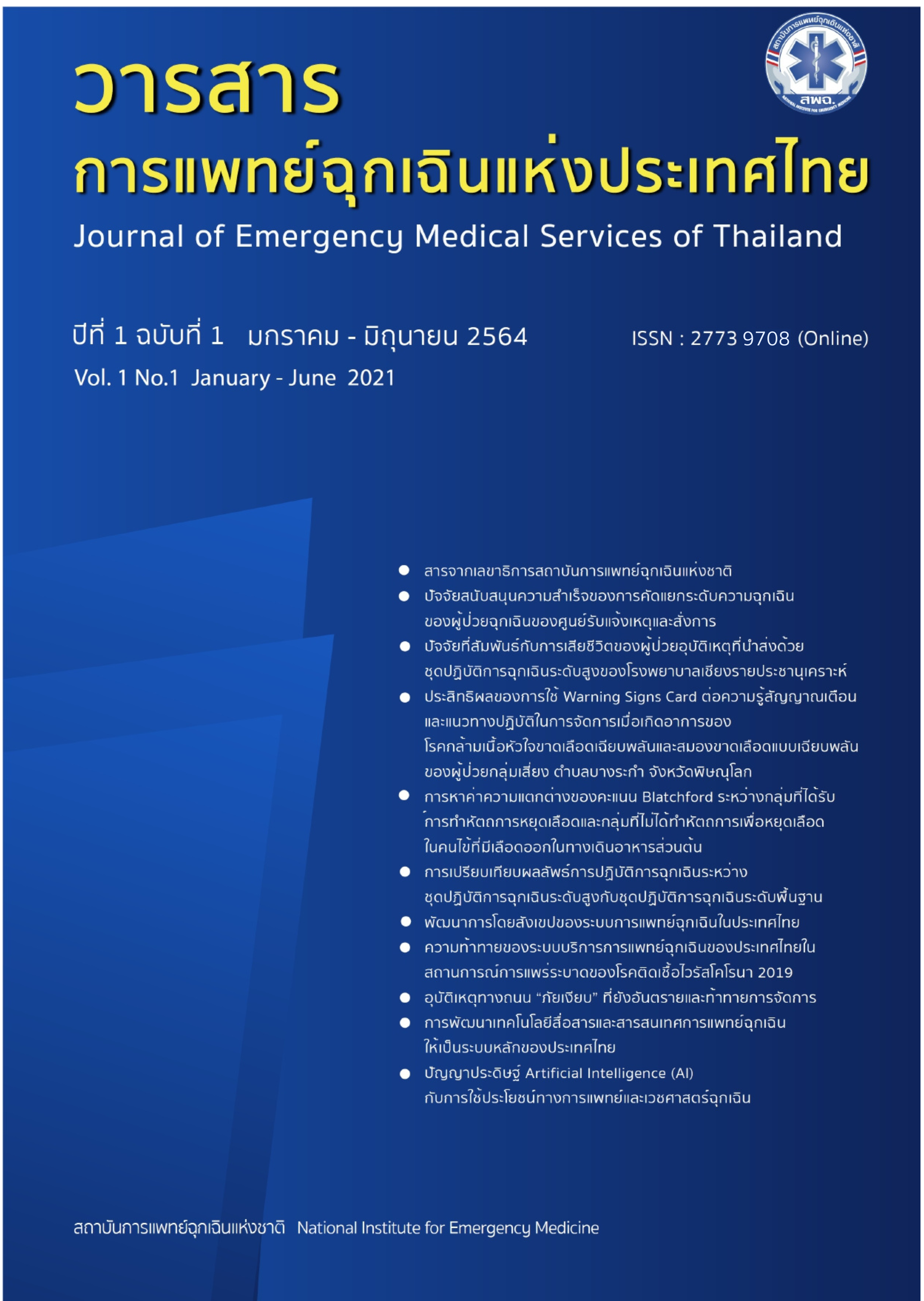The Differences of Blatchford Score in Upper Gastrointestinal Bleeding Patients Receiving and Not-Receiving Intervention for Controlling Bleeding
DOI:
https://doi.org/10.14456/jemst.2021.4Keywords:
blatchford score, uppergastrointestinal bleeding, intervention for controlling bleedingAbstract
Upper gastrointestinal bleeding (UGIB) is a common medical emergency and relate with increased mortality. The problem commonly encountered is the lack of a tool to grade the severity in order to make judgement on hospitalization for emergency gastrointestinal endoscopy. As a result, all patients have to be admited for observation with or without upper endoscopy. This is particularly important when there are insufficient beds to provide care of hospitalized patients. The objective of this study was to determine the difference in usig Blatchford scores for classifying severity in patients with upper gastrointestinal bleeding between high-risk patients who needed endoscopy to stop bleeding and low-risk patients that did not need to stop bleeding by endoscopy. It was conducted in Maharat Nakhon Ratchasima Hospital by collecting historical data of patients with upper gastrointestinal bleeding in the Hospital, and comparing basic information and treatment data. There were altogether144 patients during the study period from March to August 2020. It was found that the group who needed a procedure to stopping bleeding procedure had a mean score significantly higher than those who did not require a procedure (9.9±2.8 vs. 7.5±3.6, p<0.05). In addition, the group of patient requiring a stopping bleeding procedure had the Blatchford score of 3 or higher. Moreover, it was found that a Blatchford score of 3 or higher could be used as a criterion for high-risk patients to admit in the hospital for urgent endoscopy.
References
Hearnshaw SA, Logan RF, Lowe D, Travis SP, Murphy MF, Palmar KR. Acute upper gastrointestinal bleeding in the UK: patient characteristics, diagnoses and outcomes in the 2007 UK audit. Gut 2011; 60: 1327–35.
Laine L, Laursen SB, Zakko L, Dalton HR, Ngu JH, Schultz M, et al. et al. Severity and outcomes of upper gastrointestinal bleeding with bloody vs coffee-grounds hematemesis. Am J Gastroenterol 2018; 113: 358-66.
Gralnek IM, Dumonceau JM, Kuipers EJ, Lanas A, Sanders DS, Kurien M, et al. Diagnosis and management of nonvariceal upper gastrointestinal hemorrhage: European Society of Gastrointestinal Endoscopy (ESGE) Guideline. Endoscopy 2015; 47: a1-46.
Sung JJ, Chiu PW, Chan FKL, Lau JY, Goh KL, Ho LH, et al. Asia-Pacific working group consensus on non-variceal upper gastrointestinal bleeding: an update 2018. Gut 2018; 67: 1757-68.
JansenL,LeffersP,HermansM,StassenP,MascleeA, Keulemans Y. Identification of patients with upper gastrointestinal bleeding who do not need immediate treatment. Netherlands Journal of Medicine 2011; 69: 384- 8.
Barkun AN, Almadi M, Kuipers EJ, Laine L, Sung J, Tse F, et al. Management of nonvariceal upper gastrointestinal bleeding: guideline rec- ommendations from the International Consensus Group. Ann Intern Med 2019; 171: 805-22.
Chantharakhit C. ความสัมพันธ์ของ Glasgow Blatchford Score กับผลลัพธ์ของผู้ป่วยภาวะเลือดออกทางเดินอาหารส่วนบนในโรงพยาบาลเพชรบูรณ์. วารสารวิชาการสาธารณสุข 2557; 23: 305-12.
Valkhoff VE, Sturkenboom MC. Risk factors for gastrointestinal bleeding associated with low-dose aspirin. Best Practice and Research Clinical Gastroenterology 2012; 25: 125-40.
Bureau of Policy and Strategy. Public Health Statistics 2015. [Internet]. 2015 [cited 2017 Dec 8]. Available from: http://bps.moph.go.th/new_bps
Crooks CJ, West J, Card TR. Comorbidities affect risk of nonvariceal upper gastrointestinal bleeding. Gastroenterology 2013; 144: 1384-93.
Lanas A, Dumonceau JM, Hunt RH, Fujishiro M, Scheiman JM, Gralnek IM, et al. Non-variceal upper gastrointestinal bleeding. Nat Rev Dis Primers 2018; 4: 18020.
Tielleman T, Bujanda D, Cryer B. Epidemiology and risk factors for upper gastrointestinal bleeding. Gastrointest Endosc Clin N Am 2015; 25: 415-28.
Oakland K. Changing epidemiology and etiology of upper and lower gastrointestinalbleeding. Best Pract Res Clin Gastroenterol 2019; 42-43: 101610.
Busch M, Schneider A, Lankisch T, von Hahn T. Acute hemorrhage in the upper gastrointestinal tract. Der Internist 2017; 58: 226-32.
ชาญชัย บุญอยู่. การจัดระบบบริการสุขภาพและกำลังคนด้านสุขภาพ จังหวัดนครราชสีมา. การประชุมขับเคลื่อนลดความแออัดในโรงพยาบาลศูนย์เขตสุขภาพที่ 9; 17 สิงหาคม 2562; โรงพยาบาลมหาราชนครราชสีมา, นครราชสีมา. นครราชสีมา: สำนักงานเขตสุขภาพที่ 9; 2562. หน้า 4-5.
Barkun AN, Almadi M, Kuipers EJ, Laine L, Sung J, Tse F Management of nonvariceal upper gastrointestinal bleeding: guideline recommendations from the International Consensus Group. Ann Intern Med 2019; 171: 805-22.
Kamboj AK, Hoversten P, Leggett CL. Upper gastrointestinal bleeding: etiologies and management. Mayo Clin Proc 2019; 94: 697-703.
Samuel R, Bilal M, Tayyem O, Guturu P. Evaluation and management of Non-variceal upper gastrointestinal bleeding. Dis Mon 2018; 64:333-43.
Stanley AJ, Laine L, Dalton HR, Ngu JH, Schultz, Abazi R, et al. International Gastrointestinal Bleeding Consortium. Comparison of risk scoring systems for patients presenting with upper gastrointestinal bleeding: international multicentre prospective study. BMJ 2017; 356: i6432.
Saltzman JR, Tabak YP, Hyett BH, Sun X, Travis AC, Johannes RS. A simple risk score accurately predicts in-hospital mortality, length of stay, and cost in acute upper GI bleeding. Gastrointest Endosc 2011; 74: 1215- 24.
Yang HM, Jeon SW, Jung JT, Lee DW, Ha CY, Park KS, et al. Daegu-Gyeongbuk Gastrointestinal Study Group (DGSG). Comparison of scoring systems for nonvariceal upper gastrointestinal bleeding: a multicenter prospective cohort study. J Gastroenterol Hepatol 2016; 31: 119-25.
Laursen SB, Hansen JM, Schaffalitzky de Muckadell OB. The Glasgow Blatchford score is the most accurate assessment of patients with upper gastrointestinal hemorrhage. Clin Gastroenterol Hepatol 2012; 10: 1130-35.
Ramaekers R, Mukarram M, Smith CA, Thiruganasambandamoorthy V. The predictive value of preendoscopic risk scores to predict adverse outcomes in emergency department patients with upper gastrointestinal bleeding: a systematic review. Acad Emerg Med 2016; 23: 1218- 27.
Blatchford O, Murray WR, Blatchford M. A risk score to predict need for treatment for upper gastrointestinal haemorrhage. Lancet 2000; 356: 1318-21.
Chen IC, Hung MS, Chiu TF, Chen JC, Hsiao CT. Risk scoring systems to predict need for clinical intervention for patients with nonvariceal upper gastrointestinal tract bleeding. Am J Emerg Med 2007; 25: 774-9.
Downloads
Published
How to Cite
Issue
Section
License
Copyright (c) 2021 ์National Institute for Emergency Medicine

This work is licensed under a Creative Commons Attribution-NonCommercial-NoDerivatives 4.0 International License.






